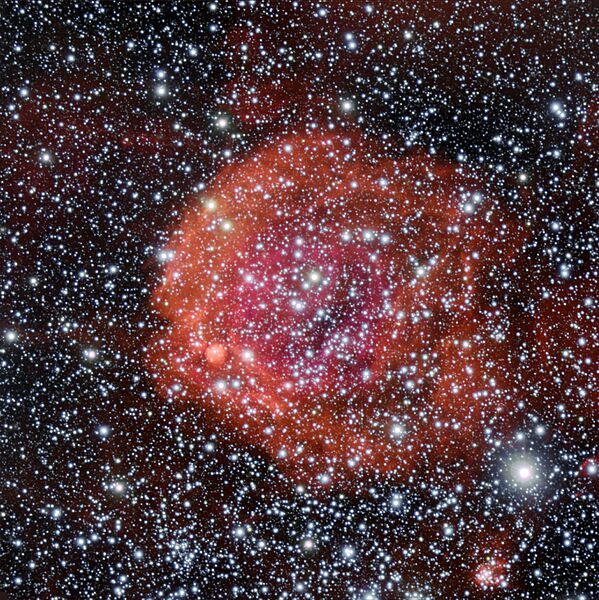Image: NGC 371

Description: This picture of the star cluster and surrounding nebula NGC 371 was taken using the FORS1 instrument on ESO’s Very Large Telescope, at the Paranal Observatory in Chile. NGC 371 lies in the Small Magellanic Cloud, one of the closest galaxies to the Milky Way. The vivid red cloud in this new image from ESO’s Very Large Telescope is a region of glowing hydrogen surrounding the star cluster NGC 371. This stellar nursery lies in our neighbouring galaxy, the Small Magellanic Cloud. The object dominating this image may resemble a pool of spilled blood, but rather than being associated with death, such regions of ionised hydrogen — known as HII regions — are sites of creation with high rates of recent star birth. NGC 371 is an example of this; it is an open cluster surrounded by a nebula. The stars in open clusters all originate from the same diffuse HII region, and over time the majority of the hydrogen is used up by star formation, leaving behind a shell of hydrogen such as the one in this image, along with a cluster of hot young stars. The host galaxy to NGC 371, the Small Magellanic Cloud, is a dwarf galaxy a mere 200 000 light-years away, which makes it one of the closest galaxies to the Milky Way. In addition, the Small Magellanic Cloud contains stars at all stages of their evolution; from the highly luminous young stars found in NGC 371 to supernova remnants of dead stars. These energetic youngsters emit copious amounts of ultraviolet radiation causing surrounding gas, such as leftover hydrogen from their parent nebula, to light up with a colourful glow that extends for hundreds of light-years in every direction. The phenomenon is depicted beautifully in this image, taken using the FORS1 instrument on ESO’s Very Large Telescope (VLT). Open clusters are by no means rare; there are numerous fine examples in our own Milky Way. However, NGC 371 is of particular interest due to the unexpectedly large number of variable stars it contains. These are stars that change in brightness over time. A particularly interesting type of variable star, known as slowly pulsating B stars, can also be used to study the interior of stars through asteroseismology [1], and several of these have been confirmed in this cluster. Variable stars play a pivotal role in astronomy: some types are invaluable for determining distances to far-off galaxies and the age of the Universe. The data for this image were selected from the ESO archive by Manu Mejias as part of the Hidden Treasures competition [2]. Three of Manu’s images made the top twenty; his picture of NGC 371 was ranked sixth in the competition. Notes [1] Asteroseismology is the study of the internal structure of pulsating stars by looking at the different frequencies at which they oscillate. This is a similar approach to the study of the structure of the Earth by looking at earthquakes and how their oscillations travel through the interior of the planet. [2] ESO’s Hidden Treasures 2010 competition gave amateur astronomers the opportunity to search through ESO’s vast archives of astronomical data, hoping to find a well-hidden gem that needed polishing by the entrants. Participants submitted nearly 100 entries and ten skilled people were awarded some extremely attractive prizes, including an all expenses paid trip for the overall winner to ESO’s Very Large Telescope (VLT) on Cerro Paranal, in Chile, the world’s most advanced optical telescope. The ten winners submitted a total of 20 images that were ranked as the highest entries in the competition out of the near 100 images. Colours & filters Band Telescope Optical HeII Very Large Telescope FORS1 Optical HeI Very Large Telescope FORS1 Optical H-alpha Very Large Telescope FORS1 .
Title: NGC 371
Credit: http://www.eso.org/public/images/eso1111a/
Author: ESO/Manu Mejias
Permission: This photograph was produced by European Southern Observatory (ESO). Their website states: "All ESO still and motion pictures, with the exception of the ESO Logo, are released under the Creative Commons Attribution 4.0 International License, unless the credit byline indicates otherwise." To the uploader: You must provide a link (URL) to the original file and the authorship information if available. This file is licensed under the Creative Commons Attribution 4.0 International license. You are free: to share – to copy, distribute and transmit the work to remix – to adapt the work Under the following conditions: attribution – You must attribute the work in the manner specified by the author or licensor (but not in any way that suggests that they endorse you or your use of the work). http://creativecommons.org/licenses/by/4.0 CC BY 4.0 Creative Commons Attribution 4.0 truetrue
Usage Terms: Creative Commons Attribution 4.0
License: CC BY 4.0
License Link: http://creativecommons.org/licenses/by/4.0
Attribution Required?: Yes
Image usage
There are no pages that link to this image.

